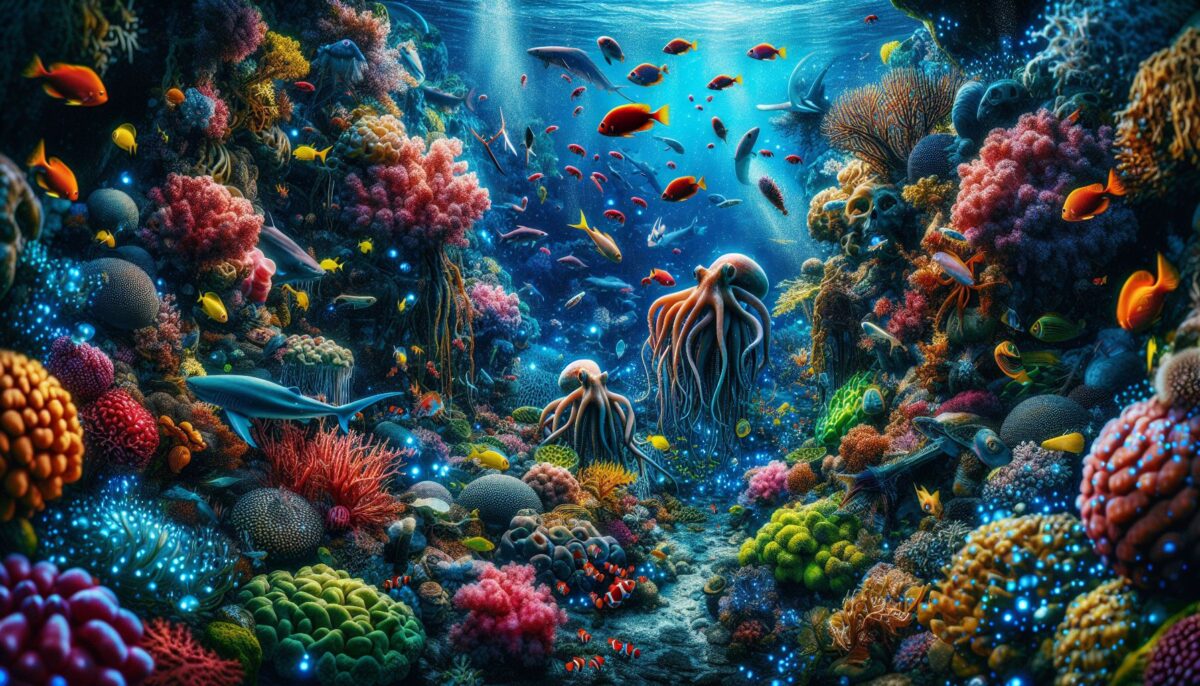If someone were to ask you to imagine the most diverse environment on earth, an image of a dense and colorful forest might be conjured up. But while terrestrial biodiversity is indeed impressive, it is outshone by the myriad of life forms that inhabit our planet’s largest environment, the oceans. Those very oceans, teeming with life, represent a world yet unexplored thoroughly. We take a deep dive below the surface to explore the incredible marine life.
From the microscopic algae to the gigantic blue whale, marine life is indeed a world fascinating and awe-inspiring. This journey to the underwater habitat, filled with a vibrant kaleidoscope of species, serves as a powerful testament to the importance of biodiversity, conservation efforts, and the role every one of us plays in preserving our blue planet.
Marine Biodiversity: A world Beneath the Surface
Marine biodiversity refers to the variety of living organisms in the ocean and other marine bodies of water. Species diversity forms an integral part of the broader concept of biodiversity, which includes the diversity within species (genetic diversity), between species, and ecosystems (1).
Our knowledge of this majestic realm is still in its infancy. Till this date, scientists believe they have only identified a fraction of marine species. According to the World Register of Marine Species (WoRMS), there are approximately 240,470 accepted descriptions of marine species, but scientists estimate that between 500,000 to 2 million additional species remain undiscovered (2).
The Cornerstone of Life: Why Marine Biodiversity Matters
Marine biodiversity is invaluable for several reasons. Firstly, the health of marine ecosystems is directly dependent on the biodiversity they hold. A greater diversity of species ensures natural sustainability and helps ecosystems recover from disturbances (3).
Furthermore, marine biodiversity is vital for human survival. It plays a crucial role in climate regulation, nutrient cycling, and provides food and livelihood to billions of people around the world. The value of marine biodiversity doesn’t stop at ecological importance. It also holds countless potential for novel pharmaceuticals and biomedical breakthroughs.
Despite its importance, marine biodiversity is under threat. Overfishing, pollution, climate change, and invasive species are pushing many marine species towards extinction. It is thus crucial that we make earnest attempts to conserve our oceans’ diverse range of organisms.
Conservation of Marine Biodiversity: Our Responsibility
Marine Protected Areas (MPAs) are one of the most effective ways to preserve marine biodiversity. These are regions in which human activity is closely regulated to protect the residing biodiversity. As of 2020, around 7.65% of the global ocean surface is under some form of protection (4).
Such protective measures are a step in the right direction, but there is so much more that we – as individuals, communities, and nations – must do to safeguard marine biodiversity. Small actions such as reducing, reusing, and recycling, supporting sustainable seafood choices, and playing active roles in coastal clean-ups can have a large cumulative impact for the better.
Moreover, it is essential to raise awareness about the importance of marine biodiversity and the threats it faces among the general public and policymakers alike.
The Future of Marine Biodiversity: A Ray of Hope
As we march forward into the future, so does the push for marine conservation. Emerging technologies such as remote sensing, satellite tracking, and genetic technologies are becoming increasingly relevant in biodiversity research and conservation. These advancements serve as a beacon of hope, illustrating that we have the tools to make substantial strides in the efforts to preserve marine biodiversity.
A world rich with biodiversity also means a world full of opportunities – for discovery, for research, for innovation, for growth. It is time we view the oceans as more than just water bodies, but as complex ecosystems teeming with life and potential.
In conclusion, marine biodiversity is a treasure trove of life that lends balance and stability to the ecosystem while serving as the backbone of numerous human economies. To secure our future and that of our planetary counterparts, it is urgent to prioritize and invest in marine biodiversity conservation. Every species in the ocean, regardless of how small it might seem, plays a crucial role in the greater marine machinery. And it’s time we take that seriously. After all, our lives and theirs are deeply interconnected. And without them, we cease to be.
Protecting our marine life and biodiversity is not only about safeguarding our ecosystem. It’s about preserving the legacy of our blue planet for generations to come.
